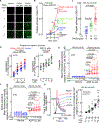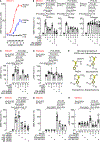A Cardiovascular Disease-Linked Gut Microbial Metabolite Acts via Adrenergic Receptors
- PMID: 32142679
- PMCID: PMC7402401
- DOI: 10.1016/j.cell.2020.02.016
A Cardiovascular Disease-Linked Gut Microbial Metabolite Acts via Adrenergic Receptors
Abstract
Using untargeted metabolomics (n = 1,162 subjects), the plasma metabolite (m/z = 265.1188) phenylacetylglutamine (PAGln) was discovered and then shown in an independent cohort (n = 4,000 subjects) to be associated with cardiovascular disease (CVD) and incident major adverse cardiovascular events (myocardial infarction, stroke, or death). A gut microbiota-derived metabolite, PAGln, was shown to enhance platelet activation-related phenotypes and thrombosis potential in whole blood, isolated platelets, and animal models of arterial injury. Functional and genetic engineering studies with human commensals, coupled with microbial colonization of germ-free mice, showed the microbial porA gene facilitates dietary phenylalanine conversion into phenylacetic acid, with subsequent host generation of PAGln and phenylacetylglycine (PAGly) fostering platelet responsiveness and thrombosis potential. Both gain- and loss-of-function studies employing genetic and pharmacological tools reveal PAGln mediates cellular events through G-protein coupled receptors, including α2A, α2B, and β2-adrenergic receptors. PAGln thus represents a new CVD-promoting gut microbiota-dependent metabolite that signals via adrenergic receptors.
Keywords: GPCR; adrenergic receptors; cardiovascular disease; gut microbe; metabolomics; thrombosis.
Copyright © 2020 Elsevier Inc. All rights reserved.
Conflict of interest statement
Declaration of Interests S.L.H. reports being named as co-inventor on pending and issued patents held by the Cleveland Clinic relating to cardiovascular diagnostics and therapeutics, being a paid consultant for P&G, having received research funds from P&G and Roche Diagnostics, and being eligible to receive royalty payments for inventions or discoveries related to cardiovascular diagnostics or therapeutics from Cleveland HeartLab, Quest Diagnostics, and P&G. The other authors have reported that they have no relationships relevant to the contents of this paper to disclose.
Figures







Comment in
-
Novel gut microbiota-derived metabolite promotes platelet thrombosis via adrenergic receptor signalling.Nat Rev Cardiol. 2020 May;17(5):265. doi: 10.1038/s41569-020-0367-y. Nat Rev Cardiol. 2020. PMID: 32210404 No abstract available.
-
Platelets get gutted by PAG.Platelets. 2020 Jul 3;31(5):618-620. doi: 10.1080/09537104.2020.1759793. Epub 2020 Apr 29. Platelets. 2020. PMID: 32348162 Free PMC article. No abstract available.
References
-
- Amrani Y, and Bradding P (2017). beta2-Adrenoceptor Function in Asthma. Adv Immunol 136, 1–28. - PubMed
-
- Anfossi G, and Trovati M (1996). Role of catecholamines in platelet function: pathophysiological and clinical significance. Eur J Clin Invest 26, 353–370. - PubMed
-
- Aron-Wisnewsky J, and Clement K (2016). The gut microbiome, diet, and links to cardiometabolic and chronic disorders. Nat Rev Nephrol 12, 169–181. - PubMed
Publication types
MeSH terms
Substances
Grants and funding
LinkOut - more resources
Full Text Sources
Other Literature Sources
Medical

